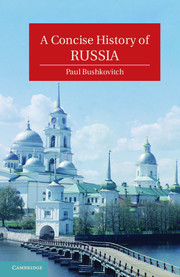Book contents
- Frontmatter
- Contents
- List of Figures
- Abbreviations
- Acknowledgments
- Prologue
- 1 Russia before Russia
- 2 Moscow, Novgorod, Lithuania, and the Mongols
- 3 The Emergence of Russia
- 4 Consolidation and Revolt
- 5 Peter the Great
- 6 Two Empresses
- 7 Catherine the Great
- 8 Russia in the Age of Revolution
- 9 The Pinnacle of Autocracy
- 10 Culture and Autocracy
- 11 The Era of the Great Reforms
- 12 From Serfdom to Nascent Capitalism
- 13 The Golden Age of Russian Culture
- 14 Russia as an Empire
- 15 Autocracy in Decline
- 16 War and Revolution
- 17 Compromise and Preparation
- 18 Revolutions in Russian Culture
- 19 Building Utopia
- 20 War
- 21 Growth, Consolidation, and Stagnation
- 22 Soviet Culture
- 23 The Cold War
- Epilogue
- Further Reading
- Index
12 - From Serfdom to Nascent Capitalism
Published online by Cambridge University Press: 05 June 2012
- Frontmatter
- Contents
- List of Figures
- Abbreviations
- Acknowledgments
- Prologue
- 1 Russia before Russia
- 2 Moscow, Novgorod, Lithuania, and the Mongols
- 3 The Emergence of Russia
- 4 Consolidation and Revolt
- 5 Peter the Great
- 6 Two Empresses
- 7 Catherine the Great
- 8 Russia in the Age of Revolution
- 9 The Pinnacle of Autocracy
- 10 Culture and Autocracy
- 11 The Era of the Great Reforms
- 12 From Serfdom to Nascent Capitalism
- 13 The Golden Age of Russian Culture
- 14 Russia as an Empire
- 15 Autocracy in Decline
- 16 War and Revolution
- 17 Compromise and Preparation
- 18 Revolutions in Russian Culture
- 19 Building Utopia
- 20 War
- 21 Growth, Consolidation, and Stagnation
- 22 Soviet Culture
- 23 The Cold War
- Epilogue
- Further Reading
- Index
Summary
The city of St. Petersburg exemplified the transformation of Russia in the decades after the emancipation of the serfs. As the nineteenth century progressed, it changed from an administrative capital of government buildings and aristocratic residences with a seaport into a major industrial center served by railroads as well as the ever-expanding port and the older canal system.
Though built as a seaport on the Baltic, the shape of the older St. Petersburg was created by the Winter Palace and the ring of military and government buildings around it. Most of these were classical in style, and three or four-stories high at most. Peter had wanted to concentrate the actual government on the north side of the Neva River, on Vasil'ev Island, but the site was too remote in the absence of permanent bridges, and in any case the government needed to be near the center of power, the tsar. Thus the Winter Palace, on the south side of the river and near the western end of Nevskii Prospekt, the main street, quickly became the center of the city. The General Staff of the army and the Ministry of Foreign Affairs were right across the Palace Square, the Ministry of Finance nearby, as well as the Senate, the Council of State, and other major offices. Only the expanded Ministry of the Interior came to occupy new buildings on the Fontanka River farther to the south. Trade and commerce, until mid-century, were concentrated along Nevskii Prospekt and on Vasil'ev Island, the latter home to the city's large German and foreign merchant population.
- Type
- Chapter
- Information
- A Concise History of Russia , pp. 208 - 227Publisher: Cambridge University PressPrint publication year: 2011

